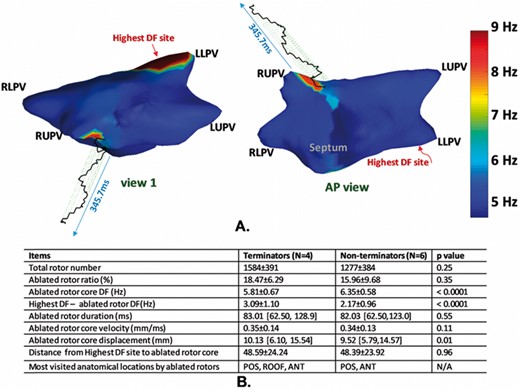-
PDF
- Split View
-
Views
-
Cite
Cite
Xin Li, Gavin S Chu, Tiago P Almeida, João L Salinet, Nawshin Dastagir, Amar R Mistry, Zakariyya Vali, Peter J Stafford, Fernando S Schlindwein, G André Ng, 5
Characteristics of ablated rotors in terminating persistent atrial fibrillation using non-contact mapping, EP Europace, Volume 19, Issue suppl_1, October 2017, Page i3, https://doi.org/10.1093/europace/eux283.145Close - Share Icon Share
Introduction: Early data has shown beneficial outcomes after rotor-guided catheter ablation in persistent atrial fibrillation (persAF). We aim to investigate the rotor characteristics at ablation sites that terminated AF (terminators) compared to those at sites that did not (non-terminators).
Methods: 10 patients undergoing left atrial (LA) persAF ablation targeting dominant frequency (DF) were enrolled. Four out of ten patients terminated after DF ablation before pulmonary vein isolation. 2048-channel virtual electrograms (VEGMs) were collected in each patient using non-contact mapping (St Jude Velocity System, Ensite Array) for 1 min. Signals were sampled at 2034.5Hz. After removal of ventricular far-field with QRS subtraction, VEGMs were bandpass filtered between 4-12 Hz using a 3rd order Chebyshev Type II filter, and the phase of VEGMs determined using Hilbert transform. Phase singularities were detected and rotors were tracked in consecutive frames for at least 50 ms. Rotor core velocity and displacement were calculated for each rotor. Ablated rotors were detected at lesion sites. Fast Fourier transform was performed to estimate the power spectrum, and DF was defined as the frequency peak (4-12 Hz) in a 2-second window. Frequency difference between highest DF across LA and DF at rotor core were generated for each rotor as well as the surface distance from highest DF site to rotor core (Figure 1A). Most visited anatomical locations by ablated rotors were summarised automatically using pre-segmented LA geometries. The above features of ablated rotors were compared between terminators and non-terminators.
Results: The total number of rotors at terminators was 1584±391 and 1277±384 in non-terminators (Figure 1B, p = 0.25). The percentage of ablated rotors over total number of rotors was slightly higher in terminators than non-terminators (18.5±6.3% vs 16.0±9.7%, p = 0.35). The rotor durations were not different between terminators and non-terminators (Median [IQR]; 83.01 [62.50-128.9] ms vs 82.03 [62.50-123.0] ms, p = 0.55). Rotor core DFs were significantly lower in terminators than non-terminators (5.81±0.67 Hz vs 6.35±0.58 Hz, p < 0.0001). Differences between highest DF and rotor core DF were higher in terminators (3.09±1.10 vs 2.17±0.96, p < 0.0001). LA surface distances from highest DF sites to rotor cores showed no differences between terminators and non-terminators (48.59±24.24 mm vs 48.39±23.92 mm, p = 0.96). The rotor core velocity was 0.35±0.14mm/ms in terminators and 0.34±0.13mm/ms in non-terminators (p = 0.11). The median rotor core displacement was 10.13 [IQR 6.10-15.54] mm in terminators and 9.52 [5.79-14.57] mm in non-terminators (p < 0.01).
Conclusion: Our data has shown that all continuous rotors found were shorter than one second using non-contact mapping. Rotor cores associated with AF termination with ablation were poorly correlated with the highest DF sites, indicating that rotor and highest DF may represent distinct mechanism participating in the initiation and maintenance of persAF. Ablated rotors in terminators showed lower core signal frequency, suggesting that targeting rotors with appropriate frequency characteristics might improve ablation outcome in persAF.

Figure 1A. An example of LA DF map during rotor presence; the trajectory of the rotor core was plotted on artificial fourth dimension representing time; the highest DF site was far away from the rotor site, but a next highest DF region was co-localised with rotor site. B. Table of features of ablated rotors in terminators and non-terminators, (mean ± std; square brackets for IQR; POS: posterior; ANT: anterior)



